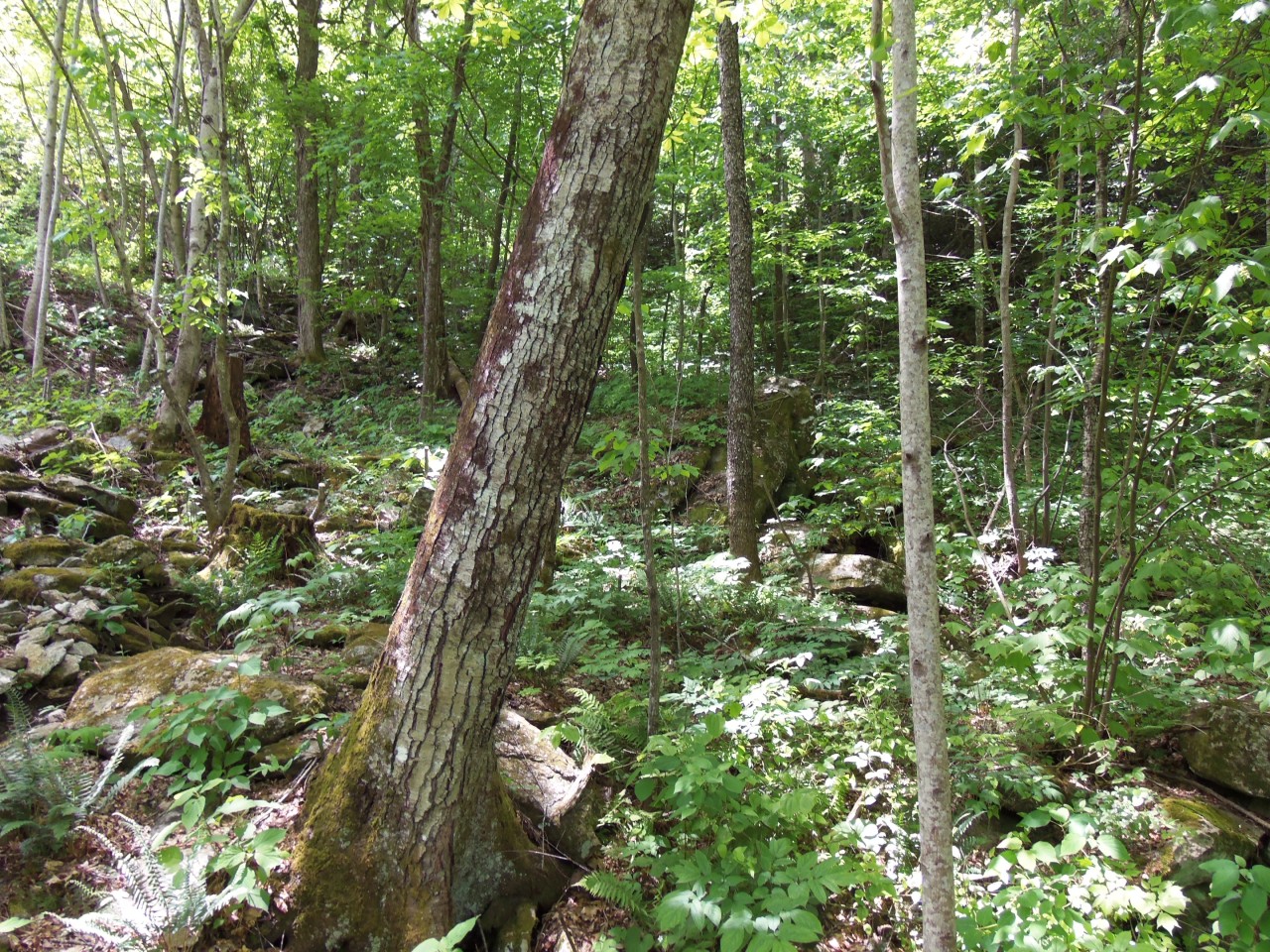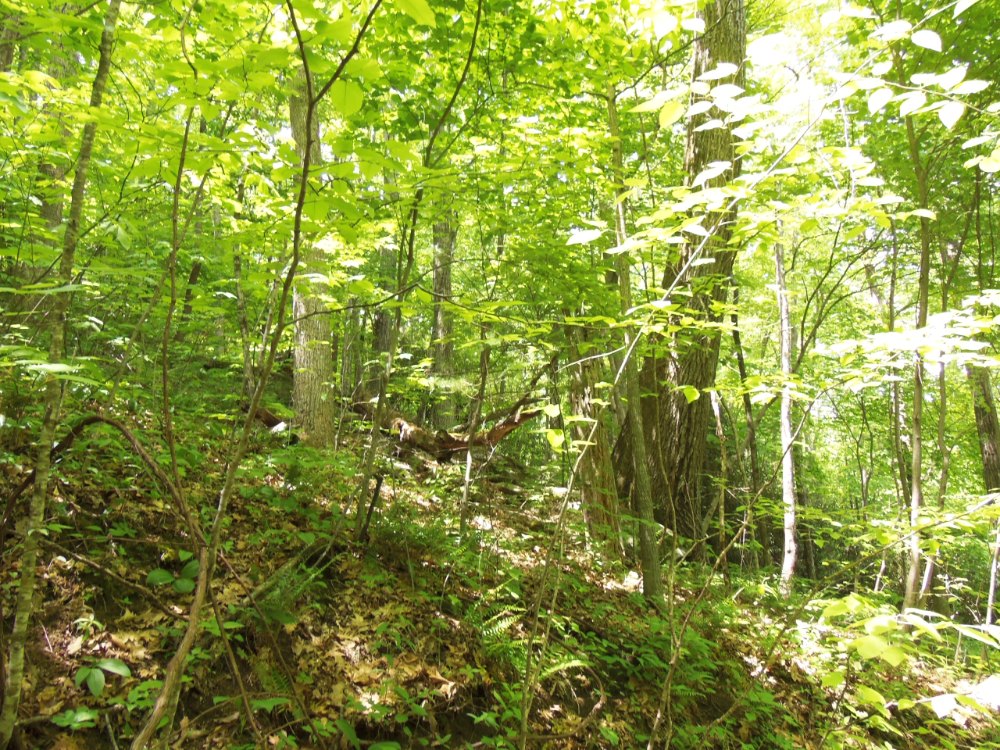New Nature Preserve Protected in Hickory Nut Gorge

A new nature preserve with old growth forest and exceptional wildlife habitat has been protected in the Hickory Nut Gorge. The 57.6-acre Chestnut Hills preserve in Gerton, NC, adjoins Conserving Carolina’s popular Wildcat Rock hiking trail and is visible from the dramatic rock overlook on that trail.
On Tuesday, Mar. 1, Conserving Carolina purchased the mountain property with plans to protect it forever with a conservation easement. Conserving Carolina intends to manage this land as a nature preserve in order to sustain its rich biodiversity and the beautiful scenery enjoyed by so many hikers.
Land Protection Director Tom Fanslow says, “The tract is north facing and provides a cool, moist refuge for species adapting to climate change, and the soils support a richer diversity of plants. Because the forest hasn’t been cut in over a century we know this older growth forest is storing many tons of carbon, and as a nature preserve the forest will continue to soak up carbon dioxide for centuries to come.”

Chestnut Hills is one of the rare tracts in Western North Carolina that was spared from industrial logging. And, for a century or more, virtually no tree cutting has occurred on the property. With its mature forests, rushing stream, boulders, and rock outcrops, the land offers rich and diverse habitat for many plants and animals. Among these are three kinds of rare salamanders, all in danger of extinction in North Carolina. With its connection to other protected forests, shaded slopes, and variety of habitat types, the preserve may serve as a refuge for species that are shifting their range in response to climate change.
State agencies have identified Chestnut Hills as a top priority for conservation. Nearly all of the preserve is part of a natural area ranked as “exceptional” by the NC Natural Heritage program. The property also scored 10 out of 10 in the Biodiversity and Wildlife Habitat Assessment conducted by the NC Wildlife Resources Commission.
Lori Williams, a biologist with the Wildlife Resources Commission, says “Preserving biodiversity in such special place as the Hickory Nut Gorge remains a top priority for conservation efforts in western North Carolina. Chestnut Hills and other protected properties help ensure the survival of rare species for the future, including some that are found nowhere else in the world.”

The new preserve connects to over a thousand acres that Conserving Carolina has already protected in the upper Hickory Nut Gorge. This block of protected lands includes the Wildcat Rock Trail, Bearwallow Mountain Trail, and Florence Nature Preserve—all part of the 100+ mile Hickory Nut Gorge State Trail that Conserving Carolina is spearheading. The extraordinary Chestnut Hills preserve helps to ensure that these hiking trails will always be surrounded by beautiful, unbroken forests.
“I Feel Patriotic About the Land:” The Earnhardt Family Story
Conserving Carolina purchased the land from Dr. Jim Earnhardt and his sister-in-law Barbara Earnhardt. The purchase was made possible by generous contributions from Esten and Burt Walker, Fred and Alice Stanback, the Fernandez Pave the Way Foundation, and the N.C. Land and Water Fund.
Chestnut Hills first came into the Earnhardt family in 1945 when Irwin Earnhardt (the father of Jim and Barbara’s late husband, Gene) purchased it, along with a business partner named N.C. English. There was a neighborhood of summer homes on the property, currently a community with 36 houses. The property also included the “upper acreage” that is now protected. Development of that tract was never seriously considered.
Barbara says, “They really believed in preserving land. I remember Irwin saying, they’re not making any new land. Irwin was really kind of a farm boy and he liked land.”
A generation later, Jim says, “We just didn’t want to see it developed.”

Jim recalls that when his family first acquired the property, you could see the crowns of dead American chestnut trees standing above the other trees in the forest. Chestnut trees, for which this land is named, were killed by a blight in the early 20th Century—although efforts continue to breed a blight-resistant variety and bring back the once dominant tree in our Southern forests.
The Earnhardts have planted experimental chestnut saplings in the Chestnut Hills neighborhood and on the nearby Florence Nature Preserve. Barbara says that her family was inspired by the example of Dr. Tom and Glenna Florence, who protected that preserve, where she has spent many hours hiking.
Another reason the Earnhardts chose to conserve their forest was to protect the springs that provide a key water source for the Chestnut Hills neighborhood. By extension, they see this nature preserve contributing to clean water sources far downstream, in the rivers that flow through the Piedmont.
Jim and Barbara and their families grew up hiking in these woods, discovering breathtaking wildflowers and occasionally a rattlesnake. Now retired, Jim and Barbara both live in the Chestnut Hills neighborhood. Their grown children appreciate the magnificence of the protected forest, Barbara says.
She says, “I feel patriotic about the land and its care.”
She sees this conservation project as preserving the heritage of Native people, whose presence is recalled by the projectile points found there, especially near the spring. The land also carries the history of the great American chestnut trees, which once turned whole hillsides white with their blossoms. Now, the land’s history and its natural heritage will be carried forward for future generations, including hikers on the upper Hickory Nut Gorge trails.

Conserving Carolina is a local land trust that has protected over 47,000 acres, primarily in Henderson, Polk, Transylvania, and Rutherford counties in N.C. and the Landrum, S.C. area. It has also helped to create over 35 miles of trails and five local greenways. The mission of Conserving Carolina is to protect, restore and inspire appreciation of the natural world. To become a member or volunteer, go to conservingcarolina.org.